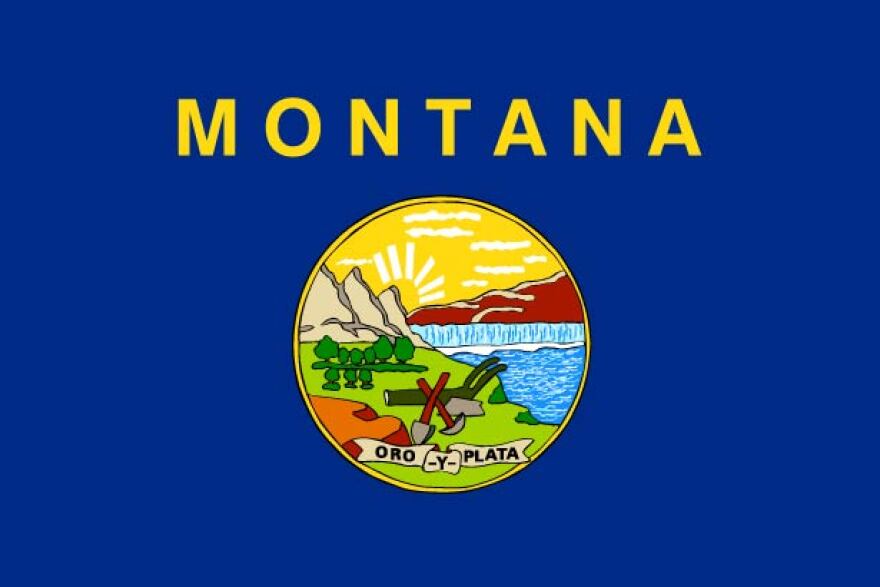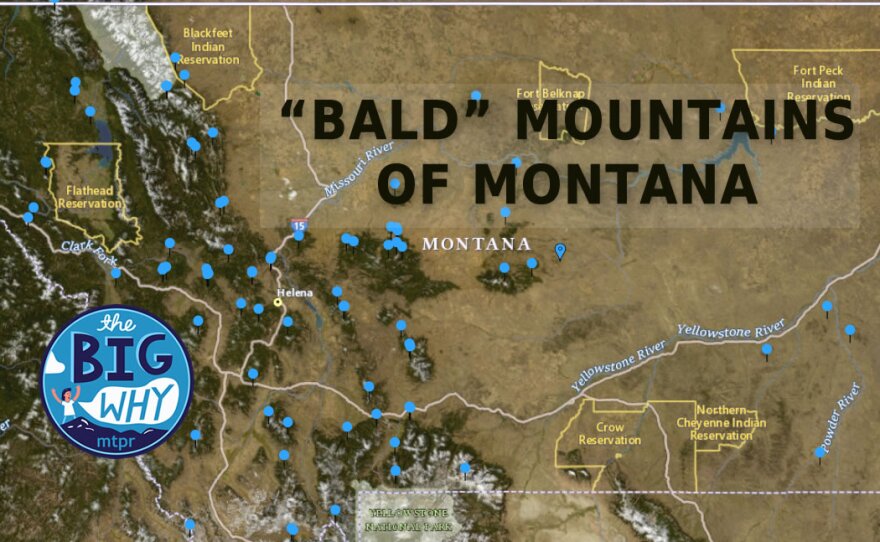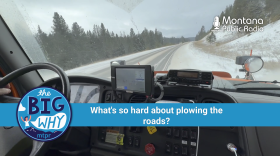Why does the state have a Spanish name? Why so many Rock Creeks? What's the deal with 'And-aconda'? Racetrack? This week, a sequel to an episode we ran all about Montana’s place names and their numerous and sometimes humorous origins.
Austin Amestoy: Welcome to The Big Why, a series from Montana Public Radio where we find out what we can discover together. I'm your host, Austin Amestoy. This is a show about listener-powered reporting. We'll answer questions, big or small, about anything under the Big Sky. By Montanans, for Montana, this is The Big Why.
This week, a sequel to an episode we ran two years ago all about Montana’s place names and their numerous and sometimes humorous origins.
Joining me for this question round-up is MTPR producer Nick Mott. Always good to have you here, Nick!
Nick Mott: Likewise, Austin. Sounds like we’ve got a few listener questions to answer today?
Austin Amestoy: Oh yes indeed. Our listeners just can’t get enough of Montana place names. I noticed a few intriguing questions about why we call things what we do as I scrolled through our list of submissions.
Nick Mott: Where should we start?
Austin Amestoy: Well, let’s start with perhaps the most obvious Big Why place-name question of all: Why do Montana’s name and motto appear to be Spanish? This question came to us from an anonymous listener.
Nick Mott: Right, “Montaña,” Spanish for “mountain.” That one, I knew. But remind us of our motto?
Austin Amestoy: “Oro y plata” — “gold and silver,” en Español.
Nick Mott: Ah, right, that’s on the state seal, which in turn is on the state flag, of course. So, why Spanish? Did Spanish settlers make it here in the state’s early days?
Austin Amestoy: Well, no, and that makes this story much more interesting than I was expecting. To find our answer, naturally, we have to wind back the clock to the state’s frontier days.
1947 Montana Travelogue: “In the northwest portion of this land of ours is Montana, the Treasure State ...”
Nick Mott: Enlisting a little help from the archives, it sounds like?
Austin Amestoy: Yes, I found a 1947 “travelogue” produced for Montana to help set the scene. You’ll note there a nickname, “The Treasure State.” That obviously evokes oro y plata, gold and silver.
1947 Montana Travelogue: “Montana’s capital city is Helena. Helena owes its existence to the discovery of gold ...”
Austin Amestoy: Montana first became of great interest to the growing United States after gold discoveries in Helena, Bannack and Virginia City in the mid 1800s. An early state Legislature later adopted “oro y plata” as the state motto to honor that history.

Nick Mott: But, that doesn’t explain why it’s in Spanish, of all languages.
Austin Amestoy: Right. To get to the bottom of that and all our place-name questions today, I knew I had to call up the Foundation for Montana History. Charlene Porsild runs the show there. We talked to her on our last place-names episode. She wrote a whole book on the origins of Montana names. This time, she brought along a colleague at the foundation, Noah Whitehorn, to help out.
Noah Whitehorn: The name "Montana" does come from "Montaña," and you’re also right, the Spanish never made it this far north. The first Europeans in Montana were French fur trappers in the late 16 and early 1700s.
Austin Amestoy: Whitehorn says “Montana” got its name at the urging of James Ashley. He was a U.S. congressman from Ohio at the time, and chaired the committee charged with drawing and naming new territories.
Nick Mott: But, obviously we lost the Spanish pronunciation in the process?
Austin Amestoy: That’s right. Interestingly, “Montana” is also just the Latin word for “mountainous area,” and Spanish is derived from Latin, of course. So there are some conflicting reports on if it was the Spanish or Latin word that inspired the name. But, the Spanish root is of course the story that’s become most prominent, and likely what inspired early lawmakers to go with “oro y plata” as the state motto, instead of the English phrase.
1947 Montana Travelogue: “Yes, Montana is indeed the Treasure State. Land of the Shining Mountains, in this land of ours ...”
Nick Mott: Alright, where to next?
Austin Amestoy: How about southwest Montana’s historic smelting town of Anaconda, Montana? Or is it 'And-aconda?' Missoula resident Kim Thomas wanted to know.
Kim Thomas: I’ve lived here over 40 years, and it seems like many, many years, maybe 30 years ago, I heard a newscaster actually pronounce it ‘And-a-conda,’ and I was like, ‘What?’
Nick Mott: Is it a regional dialect? An inside joke? Just a mispronunciation?
Austin Amestoy: Based on my conversations and research, probably a blend of the last two options. Noah Whitehorn at the Foundation for Montana History says they couldn’t find any historical documentation for that alternate pronunciation of Anaconda. As fortune has it, however, Whitehorn also has a background in linguistics. And therein may lie the answer.
Noah Whitehorn: It likely comes from people trying to say the word ‘Anaconda,’ like the snake, really fast.
Nick Mott: Huh. Anaconda Anaconda Anaconda Anaconda. You know, I do hear the “duh” sound slipping in there!
Austin Amestoy: Right? Whitehorn says it’s likely as simple as the tongue striking the same general spot when we make the “nuh” and “duh” sounds in English. The faster you do it, the more likely it is you make the “duh” sound.
That said, Whitehorn suggested there may be more to this story for folks living in the region between Butte and Deer Lodge. If you’ve got a take on “Anaconda” vs “And-a-conda,” write into the show, I’d love to hear it.
Alright, now we’re really cruising, Nick. Our next question takes us just 20 minutes north on I-90. An anonymous listener wanted to know what the deal is with the unincorporated community of “Racetrack” Montana.
Nick Mott: Oh yeah, I’ve seen the sign for the Racetrack exit a few times driving down the interstate. I assume there’s a racetrack nearby?
Austin Amestoy: A great guess, Nick. Let’s see what historian Charlene Porsild has to say.
Charlene Porsild: So, it’s a really old racetrack! Really old.
Austin Amestoy: So old, in fact, that there’s no evidence left that it was ever there, which is what prompted our listener’s question. Porsild says the wide, flat valley there was home to Indigenous horse racing long before settlers arrived. Then, in the late 1800s, two ranching barons in the region established a formal horse racing track in that location that quickly grew in acclaim.
Charlene Porsild: It was well-enough known that it was publicized in San Francisco in a magazine called ‘Breeder and Sportsman.’ So, it was attracting people and attention all around the West.
Nick Mott: So, the track obviously lost its popularity over time, but the place name stuck?
Austin Amestoy: That’s right. A nearby lake, creek and mountain also bear the name. It’s a common type of Montana place name: a descriptive name. We talked about those a lot in our first episode on place names, and that’s where we’ll close this one, too.
Our final question comes to us from Montana’s far northeastern corner.
Paul Kanning: Yeah, I’m Paul Kanning, and I live in Flaxville, Montana.
Austin Amestoy: Paul is a farmer who says he listens to the Big Why out on his tractor. One day, he was pondering why so many features in Montana bear the same name.
Nick Mott: Right, I remember the last time we talked place names, you found Montana has 40-something mountains named “Baldy.”
Austin Amestoy: That’s right. The gist is that settlers often named something based on what it looked like or what was in it or near it. This was done to make it easy to remember a location’s name and help others find it.
Paul was particularly curious to know how many “Rock,” “Coal,” and “Mill” creeks Montana has.
Nick Mott: What did you find out?
Austin Amestoy: The U.S. Geological Survey database lists 96 streams or creeks with “rock” as their formal or informal name. Paul found that slightly surprising.
Paul Kanning: I had no idea it would be that high, wow!
Austin Amestoy: The database recorded 56 “Coal Creeks” and 44 “Mill Creeks.” Paul was also curious why those really common place names aren’t changed more often, to make it easier to distinguish them from each other.
Historian Charlene Porsild says that’s probably just human nature. Communities grow attached to their local places, and changing names can often change something’s entire identity.
Austin Amestoy: The point is, Nick, place names can originate from anywhere, but once they’re established, they’re hard to shake.
Nick Mott: Austin, thanks for the history lesson!
View the USGS place name database
Now we want to know what makes you curious about Montana. Submit your questions below, or leave a message at 406-640-8933. Let's see what we can discover together!
Find us wherever you listen to podcasts and help others find the show by sharing it and leaving a review.
-
When it comes to winter driving, everyone wants their route clear and dry, and they want it done quickly. Why don't the plows come sooner or more often? Why don't they drop more salt or deicer? Why not get more drivers on the road? Tag along as a Montana snowplow driver prepares for a big winter storm and find out more about the logistical, environmental and technical challenges that come with keeping the roads clear of snow.
-
How do cabbage and spices become ingredients for community building? In Korea, the answer is kimjang, the fall tradition of making and sharing kimchi. This week on The Big Why, we visit a farm in the Bitterroot Valley where a group of Montanans came together to keep a food custom alive and find comfort and connection among the cabbage.
-
In Montana, abortion access has been at times illegal, legal, and stuck in limbo. Providers have weathered bombings and arson, advocates and opponents have battled it out in court, and citizens have passed a constitutional amendment affirming a woman's right to choose. One listener wants to know more about the history of reproductive rights in Montana. MTPR's Aaron Bolton reports on the underground networks, political violence and landmark court cases that got us to where we are today.
-
A flag's primary purpose is to be recognized from a distance. That means few colors, no lettering and a clear distinction from other flags. Ideally, it should be simple enough for a child to draw it from memory. So, how did Montana end up with such a complicated flag? Learn more in this episode of The Big Why.










